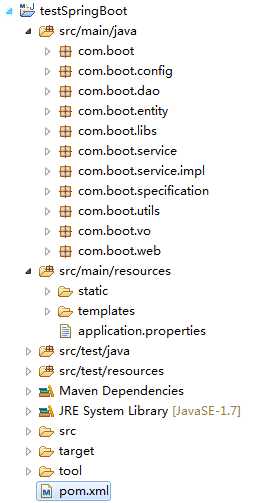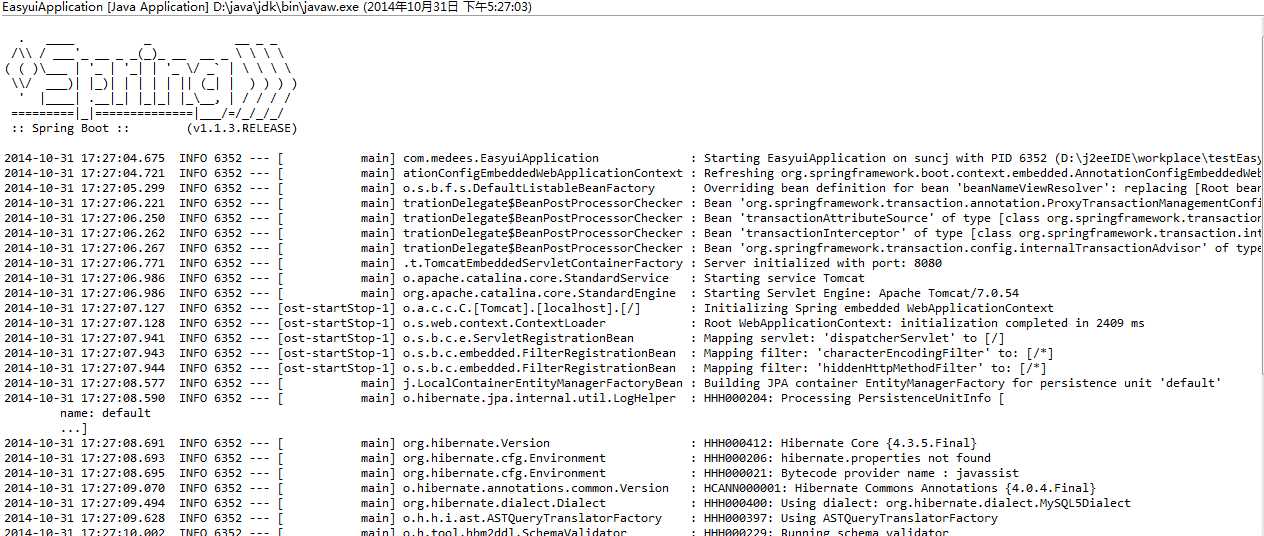标签:tmp reading bug when pattern cat port pom set
1、创建一个maven项目,pom.xml文件里面写这些:
<project xmlns="http://maven.apache.org/POM/4.0.0" xmlns:xsi="http://www.w3.org/2001/XMLSchema-instance" xsi:schemaLocation="http://maven.apache.org/POM/4.0.0 http://maven.apache.org/xsd/maven-4.0.0.xsd"> <modelVersion>4.0.0</modelVersion> <groupId>springboot</groupId> <artifactId>testSpringBoot</artifactId> <version>0.0.1-SNAPSHOT</version> <name>testSpringBoot</name> <packaging>jar</packaging> <!-- 继承父包 --> <parent> <groupId>org.springframework.boot</groupId> <artifactId>spring-boot-starter-parent</artifactId> <version>1.1.3.RELEASE</version> <relativePath></relativePath> </parent> <!-- spring-boot的web启动的jar包 --> <dependencies> <dependency> <groupId>org.springframework.boot</groupId> <artifactId>spring-boot-starter-web</artifactId> </dependency> <!--jpa的jar包 ,操作数据库的,类似hibernate--> <dependency> <groupId>org.springframework.boot</groupId> <artifactId>spring-boot-starter-data-jpa</artifactId> </dependency> <!--mysql驱动--> <dependency> <groupId>mysql</groupId> <artifactId>mysql-connector-java</artifactId> </dependency> <!--thymeleaf模板jar,是很不错的html数据传递取值,类似jsp的jstl--> <dependency> <groupId>org.springframework.boot</groupId> <artifactId>spring-boot-starter-thymeleaf</artifactId> </dependency> </dependencies> <!--maven的插件--> <build> <plugins> <plugin> <groupId>org.springframework.boot</groupId> <artifactId>spring-boot-maven-plugin</artifactId> </plugin> </plugins> <!-- 配置java版本 不配置的话默认父类配置的是1.6--> <pluginManagement> <plugins> <plugin> <artifactId>maven-compiler-plugin</artifactId> <configuration> <source>1.7</source> <target>1.7</target> </configuration> </plugin> </plugins> </pluginManagement> </build> </project>
2、创建的文件目录如图:

3、在com.boot(即最外层目录文件)下写一个如下main方法:
package com.boot; import org.springframework.boot.SpringApplication; import org.springframework.boot.autoconfigure.EnableAutoConfiguration; import org.springframework.context.annotation.ComponentScan; import org.springframework.context.annotation.Configuration; @Configuration @EnableAutoConfiguration @ComponentScan public class Application { public static void main(String[] args) { SpringApplication.run(Application.class, args); } }
4、在com.boot.web下创建一个类如下:
package com.boot.web; import org.springframework.stereotype.Controller; import org.springframework.web.bind.annotation.RequestMapping; import org.springframework.web.bind.annotation.ResponseBody; @Controller public class MainController { // @RequestMapping("") // public String index(){ // return "examples/index"; // } @RequestMapping("/") @ResponseBody String home() { return "Hello World!"; } }
@RequestMapping @ResponseBody
这两个注解都是springMVC的,不懂得可以看springMVC
5、在resources下增加一个application.properties文件
文件内容如下配置:
spring.datasource.platform=mysql spring.datasource.url=jdbc:mysql://localhost/springboot?useUnicode=true&characterEncoding=utf-8&zeroDateTimeBehavior=convertToNull&transformedBitIsBoolean=true&autoReconnect=true&failOverReadOnly=false spring.datasource.username=root spring.datasource.password=root spring.datasource.driverClassName=com.mysql.jdbc.Driver # Advanced configuration... spring.datasource.max-active=50 spring.datasource.max-idle=6 spring.datasource.min-idle=2 spring.datasource.initial-size=6 #create table spring.jpa.hibernate.ddl-auto=validate server.port=8080 server.session-timeout=30 server.tomcat.uri-encoding=UTF-8 spring.thymeleaf.prefix=classpath:templates/ spring.thymeleaf.suffix=.html spring.thymeleaf.mode=HTML5 spring.thymeleaf.encoding=UTF-8 spring.thymeleaf.content-type=text/html spring.thymeleaf.cache=false
该文件的配置可以参考springboot的官网
该文件的全部参数配置;如下(摘自官网)
# =================================================================== # COMMON SPRING BOOT PROPERTIES # # This sample file is provided as a guideline. Do NOT copy it in its # entirety to your own application. ^^^ # =================================================================== # ---------------------------------------- # CORE PROPERTIES # ---------------------------------------- # SPRING CONFIG (ConfigFileApplicationListener) spring.config.name= # config file name (default to ‘application‘) spring.config.location= # location of config file # PROFILES spring.profiles.active= # comma list of active profiles # APPLICATION SETTINGS (SpringApplication) spring.main.sources= spring.main.web-environment= # detect by default spring.main.show-banner=true spring.main....= # see class for all properties # LOGGING logging.path=/var/logs logging.file=myapp.log logging.config= # location of config file (default classpath:logback.xml for logback) logging.level.*= # levels for loggers, e.g. "logging.level.org.springframework=DEBUG" (TRACE, DEBUG, INFO, WARN, ERROR, FATAL, OFF) # IDENTITY (ContextIdApplicationContextInitializer) spring.application.name= spring.application.index= # EMBEDDED SERVER CONFIGURATION (ServerProperties) server.port=8080 server.address= # bind to a specific NIC server.session-timeout= # session timeout in seconds server.context-path= # the context path, defaults to ‘/‘ server.servlet-path= # the servlet path, defaults to ‘/‘ server.ssl.client-auth= # want or need server.ssl.key-alias= server.ssl.key-password= server.ssl.key-store= server.ssl.key-store-password= server.ssl.key-store-provider= server.ssl.key-store-type= server.ssl.protocol=TLS server.ssl.trust-store= server.ssl.trust-store-password= server.ssl.trust-store-provider= server.ssl.trust-store-type= server.tomcat.access-log-pattern= # log pattern of the access log server.tomcat.access-log-enabled=false # is access logging enabled server.tomcat.internal-proxies=10\.\d{1,3}\.\d{1,3}\.\d{1,3}| 192\.168\.\d{1,3}\.\d{1,3}| 169\.254\.\d{1,3}\.\d{1,3}| 127\.\d{1,3}\.\d{1,3}\.\d{1,3} # regular expression matching trusted IP addresses server.tomcat.protocol-header=x-forwarded-proto # front end proxy forward header server.tomcat.port-header= # front end proxy port header server.tomcat.remote-ip-header=x-forwarded-for server.tomcat.basedir=/tmp # base dir (usually not needed, defaults to tmp) server.tomcat.background-processor-delay=30; # in seconds server.tomcat.max-threads = 0 # number of threads in protocol handler server.tomcat.uri-encoding = UTF-8 # character encoding to use for URL decoding # SPRING MVC (HttpMapperProperties) http.mappers.json-pretty-print=false # pretty print JSON http.mappers.json-sort-keys=false # sort keys spring.mvc.locale= # set fixed locale, e.g. en_UK spring.mvc.date-format= # set fixed date format, e.g. dd/MM/yyyy spring.mvc.message-codes-resolver-format= # PREFIX_ERROR_CODE / POSTFIX_ERROR_CODE spring.view.prefix= # MVC view prefix spring.view.suffix= # ... and suffix spring.resources.cache-period= # cache timeouts in headers sent to browser spring.resources.add-mappings=true # if default mappings should be added # JACKSON (JacksonProperties) spring.jackson.date-format= # Date format string (e.g. yyyy-MM-dd HH:mm:ss), or a fully-qualified date format class name (e.g. com.fasterxml.jackson.databind.util.ISO8601DateFormat) spring.jackson.property-naming-strategy= # One of the constants on Jackson‘s PropertyNamingStrategy (e.g. CAMEL_CASE_TO_LOWER_CASE_WITH_UNDERSCORES) or the fully-qualified class name of a PropertyNamingStrategy subclass spring.jackson.deserialization.*= # see Jackson‘s DeserializationFeature spring.jackson.generator.*= # see Jackson‘s JsonGenerator.Feature spring.jackson.mapper.*= # see Jackson‘s MapperFeature spring.jackson.parser.*= # see Jackson‘s JsonParser.Feature spring.jackson.serialization.*= # see Jackson‘s SerializationFeature # THYMELEAF (ThymeleafAutoConfiguration) spring.thymeleaf.prefix=classpath:/templates/ spring.thymeleaf.suffix=.html spring.thymeleaf.mode=HTML5 spring.thymeleaf.encoding=UTF-8 spring.thymeleaf.content-type=text/html # ;charset=<encoding> is added spring.thymeleaf.cache=true # set to false for hot refresh # FREEMARKER (FreeMarkerAutoConfiguration) spring.freemarker.allowRequestOverride=false spring.freemarker.cache=true spring.freemarker.checkTemplateLocation=true spring.freemarker.charSet=UTF-8 spring.freemarker.contentType=text/html spring.freemarker.exposeRequestAttributes=false spring.freemarker.exposeSessionAttributes=false spring.freemarker.exposeSpringMacroHelpers=false spring.freemarker.prefix= spring.freemarker.requestContextAttribute= spring.freemarker.settings.*= spring.freemarker.suffix=.ftl spring.freemarker.templateLoaderPath=classpath:/templates/ # comma-separated list spring.freemarker.viewNames= # whitelist of view names that can be resolved # GROOVY TEMPLATES (GroovyTemplateAutoConfiguration) spring.groovy.template.cache=true spring.groovy.template.charSet=UTF-8 spring.groovy.template.configuration.*= # See Groovy‘s TemplateConfiguration spring.groovy.template.contentType=text/html spring.groovy.template.prefix=classpath:/templates/ spring.groovy.template.suffix=.tpl spring.groovy.template.viewNames= # whitelist of view names that can be resolved # VELOCITY TEMPLATES (VelocityAutoConfiguration) spring.velocity.allowRequestOverride=false spring.velocity.cache=true spring.velocity.checkTemplateLocation=true spring.velocity.charSet=UTF-8 spring.velocity.contentType=text/html spring.velocity.dateToolAttribute= spring.velocity.exposeRequestAttributes=false spring.velocity.exposeSessionAttributes=false spring.velocity.exposeSpringMacroHelpers=false spring.velocity.numberToolAttribute= spring.velocity.prefix= spring.velocity.properties.*= spring.velocity.requestContextAttribute= spring.velocity.resourceLoaderPath=classpath:/templates/ spring.velocity.suffix=.vm spring.velocity.viewNames= # whitelist of view names that can be resolved # INTERNATIONALIZATION (MessageSourceAutoConfiguration) spring.messages.basename=messages spring.messages.cacheSeconds=-1 spring.messages.encoding=UTF-8 # SECURITY (SecurityProperties) security.user.name=user # login username security.user.password= # login password security.user.role=USER # role assigned to the user security.require-ssl=false # advanced settings ... security.enable-csrf=false security.basic.enabled=true security.basic.realm=Spring security.basic.path= # /** security.filter-order=0 security.headers.xss=false security.headers.cache=false security.headers.frame=false security.headers.contentType=false security.headers.hsts=all # none / domain / all security.sessions=stateless # always / never / if_required / stateless security.ignored=false # DATASOURCE (DataSourceAutoConfiguration & DataSourceProperties) spring.datasource.name= # name of the data source spring.datasource.initialize=true # populate using data.sql spring.datasource.schema= # a schema (DDL) script resource reference spring.datasource.data= # a data (DML) script resource reference spring.datasource.sqlScriptEncoding= # a charset for reading SQL scripts spring.datasource.platform= # the platform to use in the schema resource (schema-${platform}.sql) spring.datasource.continueOnError=false # continue even if can‘t be initialized spring.datasource.separator=; # statement separator in SQL initialization scripts spring.datasource.driver-class-name= # JDBC Settings... spring.datasource.url= spring.datasource.username= spring.datasource.password= spring.datasource.jndi-name # For JNDI lookup (class, url, username & password are ignored when set) spring.datasource.max-active=100 # Advanced configuration... spring.datasource.max-idle=8 spring.datasource.min-idle=8 spring.datasource.initial-size=10 spring.datasource.validation-query= spring.datasource.test-on-borrow=false spring.datasource.test-on-return=false spring.datasource.test-while-idle= spring.datasource.time-between-eviction-runs-millis= spring.datasource.min-evictable-idle-time-millis= spring.datasource.max-wait= # MONGODB (MongoProperties) spring.data.mongodb.host= # the db host spring.data.mongodb.port=27017 # the connection port (defaults to 27107) spring.data.mongodb.uri=mongodb://localhost/test # connection URL spring.data.mongo.repositories.enabled=true # if spring data repository support is enabled # JPA (JpaBaseConfiguration, HibernateJpaAutoConfiguration) spring.jpa.properties.*= # properties to set on the JPA connection spring.jpa.openInView=true spring.jpa.show-sql=true spring.jpa.database-platform= spring.jpa.database= spring.jpa.generate-ddl=false # ignored by Hibernate, might be useful for other vendors spring.jpa.hibernate.naming-strategy= # naming classname spring.jpa.hibernate.ddl-auto= # defaults to create-drop for embedded dbs spring.data.jpa.repositories.enabled=true # if spring data repository support is enabled # JTA (JtaAutoConfiguration) spring.jta.log-dir= # transaction log dir spring.jta.*= # technology specific configuration # SOLR (SolrProperties}) spring.data.solr.host=http://127.0.0.1:8983/solr spring.data.solr.zkHost= spring.data.solr.repositories.enabled=true # if spring data repository support is enabled # ELASTICSEARCH (ElasticsearchProperties}) spring.data.elasticsearch.cluster-name= # The cluster name (defaults to elasticsearch) spring.data.elasticsearch.cluster-nodes= # The address(es) of the server node (comma-separated; if not specified starts a client node) spring.data.elasticsearch.repositories.enabled=true # if spring data repository support is enabled # DATA RESET (RepositoryRestConfiguration}) spring.data.rest.baseUri=foo # base URI against which the exporter should calculate its links # FLYWAY (FlywayProperties) flyway.locations=classpath:db/migrations # locations of migrations scripts flyway.schemas= # schemas to update flyway.initVersion= 1 # version to start migration flyway.sql-migration-prefix=V flyway.sql-migration-suffix=.sql flyway.enabled=true flyway.url= # JDBC url if you want Flyway to create its own DataSource flyway.user= # JDBC username if you want Flyway to create its own DataSource flyway.password= # JDBC password if you want Flyway to create its own DataSource # LIQUIBASE (LiquibaseProperties) liquibase.change-log=classpath:/db/changelog/db.changelog-master.yaml liquibase.contexts= # runtime contexts to use liquibase.default-schema= # default database schema to use liquibase.drop-first=false liquibase.enabled=true liquibase.url= # specific JDBC url (if not set the default datasource is used) liquibase.user= # user name for liquibase.url liquibase.password= # password for liquibase.url # JMX spring.jmx.enabled=true # Expose MBeans from Spring # RABBIT (RabbitProperties) spring.rabbitmq.host= # connection host spring.rabbitmq.port= # connection port spring.rabbitmq.addresses= # connection addresses (e.g. myhost:9999,otherhost:1111) spring.rabbitmq.username= # login user spring.rabbitmq.password= # login password spring.rabbitmq.virtualHost= spring.rabbitmq.dynamic= # REDIS (RedisProperties) spring.redis.host=localhost # server host spring.redis.password= # server password spring.redis.port=6379 # connection port spring.redis.pool.max-idle=8 # pool settings ... spring.redis.pool.min-idle=0 spring.redis.pool.max-active=8 spring.redis.pool.max-wait=-1 spring.redis.sentinel.master= # name of Redis server spring.redis.sentinel.nodes= # comma-separated list of host:port pairs # ACTIVEMQ (ActiveMQProperties) spring.activemq.broker-url=tcp://localhost:61616 # connection URL spring.activemq.user= spring.activemq.password= spring.activemq.in-memory=true # broker kind to create if no broker-url is specified spring.activemq.pooled=false # HornetQ (HornetQProperties) spring.hornetq.mode= # connection mode (native, embedded) spring.hornetq.host=localhost # hornetQ host (native mode) spring.hornetq.port=5445 # hornetQ port (native mode) spring.hornetq.embedded.enabled=true # if the embedded server is enabled (needs hornetq-jms-server.jar) spring.hornetq.embedded.serverId= # auto-generated id of the embedded server (integer) spring.hornetq.embedded.persistent=false # message persistence spring.hornetq.embedded.data-directory= # location of data content (when persistence is enabled) spring.hornetq.embedded.queues= # comma-separated queues to create on startup spring.hornetq.embedded.topics= # comma-separated topics to create on startup spring.hornetq.embedded.cluster-password= # customer password (randomly generated by default) # JMS (JmsProperties) spring.datasource.jndi-name= # JNDI location of a JMS ConnectionFactory spring.jms.pub-sub-domain= # false for queue (default), true for topic # SPRING BATCH (BatchDatabaseInitializer) spring.batch.job.names=job1,job2 spring.batch.job.enabled=true spring.batch.initializer.enabled=true spring.batch.schema= # batch schema to load # AOP spring.aop.auto= spring.aop.proxy-target-class= # FILE ENCODING (FileEncodingApplicationListener) spring.mandatory-file-encoding=false # SPRING SOCIAL (SocialWebAutoConfiguration) spring.social.auto-connection-views=true # Set to true for default connection views or false if you provide your own # SPRING SOCIAL FACEBOOK (FacebookAutoConfiguration) spring.social.facebook.app-id= # your application‘s Facebook App ID spring.social.facebook.app-secret= # your application‘s Facebook App Secret # SPRING SOCIAL LINKEDIN (LinkedInAutoConfiguration) spring.social.linkedin.app-id= # your application‘s LinkedIn App ID spring.social.linkedin.app-secret= # your application‘s LinkedIn App Secret # SPRING SOCIAL TWITTER (TwitterAutoConfiguration) spring.social.twitter.app-id= # your application‘s Twitter App ID spring.social.twitter.app-secret= # your application‘s Twitter App Secret # SPRING MOBILE SITE PREFERENCE (SitePreferenceAutoConfiguration) spring.mobile.sitepreference.enabled=true # enabled by default # SPRING MOBILE DEVICE VIEWS (DeviceDelegatingViewResolverAutoConfiguration) spring.mobile.devicedelegatingviewresolver.enabled=true # disabled by default spring.mobile.devicedelegatingviewresolver.normalPrefix= spring.mobile.devicedelegatingviewresolver.normalSuffix= spring.mobile.devicedelegatingviewresolver.mobilePrefix=mobile/ spring.mobile.devicedelegatingviewresolver.mobileSuffix= spring.mobile.devicedelegatingviewresolver.tabletPrefix=tablet/ spring.mobile.devicedelegatingviewresolver.tabletSuffix= # ---------------------------------------- # ACTUATOR PROPERTIES # ---------------------------------------- # MANAGEMENT HTTP SERVER (ManagementServerProperties) management.port= # defaults to ‘server.port‘ management.address= # bind to a specific NIC management.contextPath= # default to ‘/‘ management.add-application-context-header= # default to true # ENDPOINTS (AbstractEndpoint subclasses) endpoints.autoconfig.id=autoconfig endpoints.autoconfig.sensitive=true endpoints.autoconfig.enabled=true endpoints.beans.id=beans endpoints.beans.sensitive=true endpoints.beans.enabled=true endpoints.configprops.id=configprops endpoints.configprops.sensitive=true endpoints.configprops.enabled=true endpoints.configprops.keys-to-sanitize=password,secret,key # suffix or regex endpoints.dump.id=dump endpoints.dump.sensitive=true endpoints.dump.enabled=true endpoints.env.id=env endpoints.env.sensitive=true endpoints.env.enabled=true endpoints.env.keys-to-sanitize=password,secret,key # suffix or regex endpoints.health.id=health endpoints.health.sensitive=false endpoints.health.enabled=true endpoints.health.time-to-live=1000 endpoints.info.id=info endpoints.info.sensitive=false endpoints.info.enabled=true endpoints.metrics.id=metrics endpoints.metrics.sensitive=true endpoints.metrics.enabled=true endpoints.shutdown.id=shutdown endpoints.shutdown.sensitive=true endpoints.shutdown.enabled=false endpoints.trace.id=trace endpoints.trace.sensitive=true endpoints.trace.enabled=true # HEALTH INDICATORS health.diskspace.path=. health.diskspace.threshold=10485760 # MVC ONLY ENDPOINTS endpoints.jolokia.path=jolokia endpoints.jolokia.sensitive=true endpoints.jolokia.enabled=true # when using Jolokia # JMX ENDPOINT (EndpointMBeanExportProperties) endpoints.jmx.enabled=true endpoints.jmx.domain= # the JMX domain, defaults to ‘org.springboot‘ endpoints.jmx.unique-names=false endpoints.jmx.staticNames= # JOLOKIA (JolokiaProperties) jolokia.config.*= # See Jolokia manual # REMOTE SHELL shell.auth=simple # jaas, key, simple, spring shell.command-refresh-interval=-1 shell.command-path-patterns= # classpath*:/commands/**, classpath*:/crash/commands/** shell.config-path-patterns= # classpath*:/crash/* shell.disabled-plugins=false # don‘t expose plugins shell.ssh.enabled= # ssh settings ... shell.ssh.keyPath= shell.ssh.port= shell.telnet.enabled= # telnet settings ... shell.telnet.port= shell.auth.jaas.domain= # authentication settings ... shell.auth.key.path= shell.auth.simple.user.name= shell.auth.simple.user.password= shell.auth.spring.roles= # GIT INFO spring.git.properties= # resource ref to generated git info properties file
6、找到com.boot下的Application以java Application方式启动,然后打开浏览器输入localhost:8080就会出现Hello World!
这样一个简单的web开发就搭建好了。
7、启动图片:

标签:tmp reading bug when pattern cat port pom set
原文地址:http://www.cnblogs.com/sutao/p/7634258.html